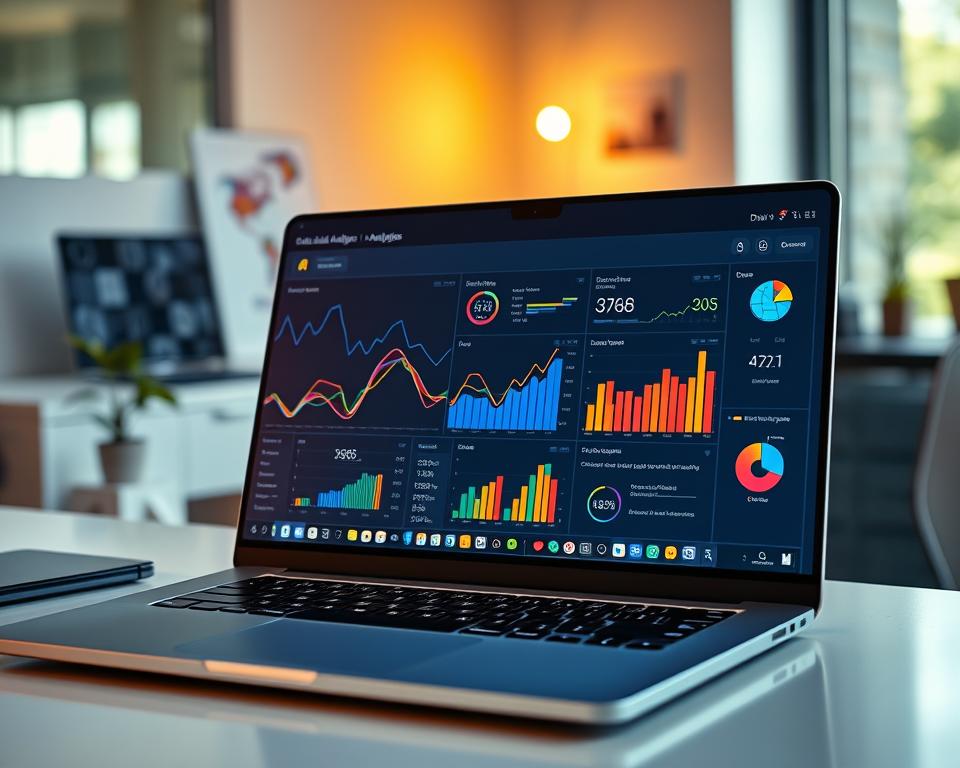Anúncios
Can you name the single signal that tells you whether your brand is growing or just noisy?
Your goal is clear: turn awareness into action. You need a simple, practical way to track what people think, feel, and do. This guide shows how to use data and sensible metrics to spot real changes in attention and value.
You’ll learn which numbers move the needle — from spikes in direct and referral traffic during launches to NPS as a loyalty signal. We explain how website behavior, search demand, and social reach tie into consideration and purchase.
Expect clear examples of what to watch in Google tools, how to align measurement with your goals, and how to turn insights into a repeatable strategy that helps your marketing program deliver business value over time.
Anúncios
Why Measuring Brand Performance Matters Right Now
Knowing how your brand performs right now lets you shift budget and messages before small issues become big problems. Quick checks on awareness and traffic show whether your campaign is creating attention or just noise.
When you track web traffic and social engagement, you see which channels are earning attention and which need pruning. Spikes in referral or organic traffic during launches, funding news, or holiday pushes are clear signs your message landed.
Website signals matter. Conversion rate and bounce rate tell you if visits are meaningful. Consistent growth in direct traffic signals stronger recall and loyalty from customers.
Anúncios
- Measure share of voice to spot gaps in the market and prioritize growth moves.
- Compare before/after campaign traffic and engagement to prove impact and optimize spend.
- Combine quantitative data with customer feedback to understand why people act the way they do.
Investing a little time in steady monitoring gives you an early-warning system that protects budget and speeds better decisions.
How to Choose the Right Branding Analytics Metrics for Your Goals
Start by picking a few measurable signals that predict progress toward your business goals. Define the outcome you want, then choose each metric as a lead indicator of that outcome. This keeps your work practical and prevents unnecessary tracking.
Use SMART criteria and align to business outcomes
Make every chosen metric specific, measurable, achievable, relevant, and time-bound. Tie each one to a campaign touchpoint you can influence this quarter. Pick a small set of KPIs from the larger list so your team stays focused on what moves awareness, consideration, and conversion.
Benchmark against competitors to reveal gaps and opportunities
Measure your brand’s visibility, sentiment, and reach alongside peers in your industry. Benchmarks show where to invest content, paid media, or PR to close gaps.
“Document baselines before your next launch so changes are clearly attributable.”
- Map indicators to the customer journey.
- Align data collection with campaign timing.
- Pair numbers with qualitative insights to get a fuller view.
Brand Awareness Metrics That Build Market Presence
Begin with reach to map your audience size, then use frequency to tune memorability without fatigue. These are the basics that tell you whether your messages are seen and remembered.
Reach, impressions, and effective frequency for recall
Reach counts unique users. Impressions count total views, including repeats.
Aim for an effective frequency between 3 and 7 per user to boost recall without causing fatigue.
Share of Voice vs. Share of Impressions to gauge visibility quality
Share of Voice shows your portion of conversations or exposure versus competitors.
Share of Impressions or publisher authority lets you judge the quality of that exposure.
Branded search volume and Google Trends for demand signals
Branded search volume is a real-time pulse of demand and often rises after PR or social activations.
Tools like Google Search Console and Google Trends reveal regional patterns so you can localize where awareness lags.
- Measure reach and impressions to manage frequency and avoid overexposure.
- Use SOV and impression quality to compare against market share and opportunity.
- Track branded vs non-branded search to separate loyalty from discovery.
“Spikes in branded search often point to higher purchase intent—watch them after campaigns and PR.”
Website and SEO Signals That Show Awareness Turning into Action
Your website data can show when attention turns into action—if you know which signals to watch. Look for clear shifts in total web traffic, session duration, and conversion rate to tell whether visits are meaningful.
Direct, referrals, and attribution to track campaign impact
Watch direct visits for a quick read on brand recall. When more people type your URL, your brand is sticking.
Analyze referral sources to see which placements and social media posts bring engaged users with low bounce rates and good session length.
Use campaign tagging and simple attribution (first-click or linear) to connect campaigns to assisted conversions. This proves value beyond last-click wins.
- Segment by source: organic, direct, referral, and social media to find what drives engaged visitors.
- Top pages and exit paths: monitor them to fix friction fast and improve the visitor journey.
- Tie entry points to value: track how different channels affect lead quality and customer outcomes.
Treat your site as a living asset—dashboards and tests help you react during a campaign, not after it ends.
Social Media and Media Coverage: From Buzz to Business Impact
When social media and press coverage line up, you can trace which stories actually move people to your site or product pages. Track follower growth alongside post-level engagement to see if your content fits the audience you want.
Followers, engagement, and social shares that indicate audience fit
Count followers, but prioritize interactions. Shares, likes, and comments show which formats and topics attract the right people.
Use post-level engagement to repurpose winners across platforms and improve campaign ROI.
Mentions, coverage mix, and message pull-through quality
Track the volume and type of media coverage—features, bylines, and quick mentions—and score whether your key messages appear in stories.
Compare Share of Voice with Share of Impressions to spot whether fewer, high-quality placements beat many low-value mentions.
Backlinks as authority and discoverability multipliers
Backlinks from authoritative outlets lift discovery and organic rankings.
Use guest posts, data studies, and partners to build links, and add UTM-tagged links so you can tie coverage to site visits and conversions.
“Monitor social shares and coverage mix to find stories worth amplifying with paid support.”
- Grow followers across platforms, but focus on engagement quality over raw numbers.
- Repurpose high-engagement content to increase reach without extra spend.
- Track backlinks and UTM links to connect media coverage to conversions and long-term brand value.
Brand Health and Loyalty Metrics You Can Trust
You can trust a small set of measures to reveal whether your customers truly prefer your brand. These indicators link experience to business value so you can act quickly.
Net Promoter Score (NPS) for advocacy and churn risk
NPS asks how likely customers are to recommend you on a 0–10 scale. Promoters (9–10), Passives (7–8), Detractors (0–6). NPS = % Promoters − % Detractors. Scores above +50 are excellent.
- Segment NPS by product, region, or tenure to spot where loyalty is strongest or at risk.
- Treat NPS as a system: close the loop with Detractors and celebrate Promoters.
Customer Satisfaction (CSAT) for experience diagnostics
Measure CSAT after key touchpoints—checkout, onboarding, and support—to diagnose issues fast.
Track CSAT with operational rates like resolution time to find quick wins that lower churn.
Customer Lifetime Value (CLV) to prioritize long-term growth
CLV = Average Purchase Value × Purchase Frequency × Customer Lifespan. Stronger brands lift retention, frequency, and willingness to pay.
- Use CLV by segment to target high-value customers with tailored programs.
- Combine NPS, CSAT, and CLV into a simple dashboard that ties experience to financial value.
“Rising NPS and CSAT usually precede higher repeat purchase rate and improved CLV.”
Listening to the Voice of the Customer for Deeper Insights
Customer feedback turns vague impressions into clear actions you can test this quarter. Use a mix of review monitoring, short surveys, and conversation analysis to see why awareness or conversion stalls.
Review sites and sentiment that reveal perception drivers
Keep a close eye on Google, Yelp, G2, ZocDoc, and Angi to track product perception and experience quality.
Respond quickly to reviews so you turn feedback into fast improvements and show customers you listen.
Surveys: aided vs. unaided recall and perceived quality
Run brief surveys that include unaided recall to measure top-of-mind awareness and aided recall to test recognition.
Use clear Likert questions for brand attributes and perceived quality. Incentivize participation but keep surveys short to avoid fatigue.
Conversation analytics from calls to surface intent and friction
Apply conversation analytics to call transcripts to spot intent, objections, and competitor mentions straight from customers’ voices.
Segment feedback by channel and customer type, then pair themes with quantitative data to validate what you hear.
- Share verbatim quotes in internal briefs to keep teams grounded in real customer language.
- Turn recurring praise into messaging proof points and recurring confusion into clearer site content.
- Feed insights back into campaigns, product updates, and service training to reduce friction over time.
“Use short, targeted surveys and review monitoring together—qualitative quotes plus simple data point you toward the highest-impact fixes.”
Branding Analytics Metrics to Track Over Time
Build a steady rhythm for measurement so you catch real change, not noise.
Don’t measure once and forget. Set up real-time dashboards where possible, and schedule checks at key journey stages so your team can act in time.
Establish a clear cadence: weekly for social and web, monthly for awareness and SOV, and quarterly for NPS and CLV. Use stable definitions and consistent tags so comparisons show true progress.
- Align tracking windows with campaign phases and seasonal peaks to capture cause and effect.
- Benchmark always-on brand signals against the market to spot share gains or losses early.
- Set targets for each KPI and share results with the business so goals are clear across the team.
Archive quarterly snapshots to preserve context and avoid methodology drift. Treat your measurement program as an evolving asset and refine it as channels shift and your brand scales.
“Real-time reports keep your team in sync and prevent decisions based on old numbers.”
From Data to Decisions: Turn Metrics into Marketing Strategy
Use simple data to shape clear strategy you can test this quarter. Start by mapping where visits, session length, and bounce rate tell a different story than clicks. Segment traffic by campaign and platforms so you know which channels drive quality, not just volume.
Identify weak links and optimize content, media, and timing
Begin with your weakest link. If brand awareness is healthy but conversion rate lags, fix offer, message match, and page experience before buying more impressions.
- Build an optimization loop: analyze data, prioritize, test content and media, then scale winners.
- Attribute impact with first-click or linear models so top-of-funnel campaigns get credit.
- Monitor session duration and bounce rate by source to find platforms that drive better visits.
Align teams around real-time dashboards and shared goals
Make dashboards living tools. Give creative, media, and lifecycle teams one view of target segments and results. Use employee advocacy to expand reach and measure impressions from staff shares.
“Keep experiments small, fast, and frequent so you learn quickly and compound growth.”
Examples and Benchmarks: What “Good” Looks Like
Good examples show how a well-timed PR push can turn a single announcement into weeks of meaningful website activity.
Watch for coordinated signals. A real awareness lift will combine rises in branded search, direct traffic, and social media mentions during launches or funding news. Referral and organic traffic tend to spike first, and high-authority coverage usually yields longer sessions.

Awareness lift tied to PR, launches, and social activations
For launches, expect a clear week-over-week lift and a sustained tail. Plateaus mean you need follow-on content or another media wave.
NPS and SOV ranges to calibrate targets by industry
In many industries, a positive NPS above +50 signals strong advocacy. Compare your SOV with Share of Impressions and publication authority to judge influence, not just volume.
- مثال: coordinated PR + social posts → branded search spike + direct visits.
- High-authority referrals usually drive better engagement than low-quality mentions.
- Track platform-level performance to balance scale and visit quality.
“Use benchmarks and past campaign examples as templates to plan follow-on waves and measure real growth.”
نتیجہ
,
Let continuous tracking guide your marketing so you can act while opportunities are fresh. Use real-time dashboards to link website, social media, and search signals to clear goals.
Focus on a small set of measures—NPS, CSAT, CLV, SOV, branded search, and site behavior—to form a single view of brand health and audience value.
Keep a steady cadence, benchmark against the market, and use voice-of-customer insights to explain movement. When you simplify what you track and tie each signal to decisions, your efforts produce repeatable results and growing loyalty.



